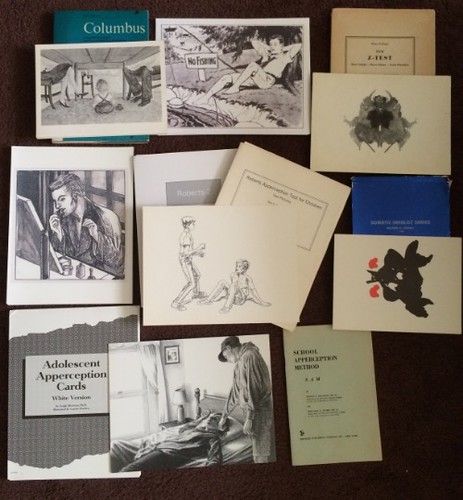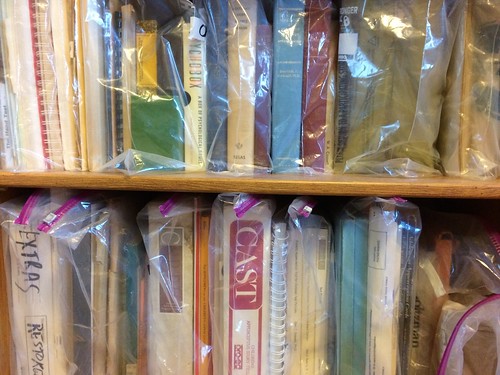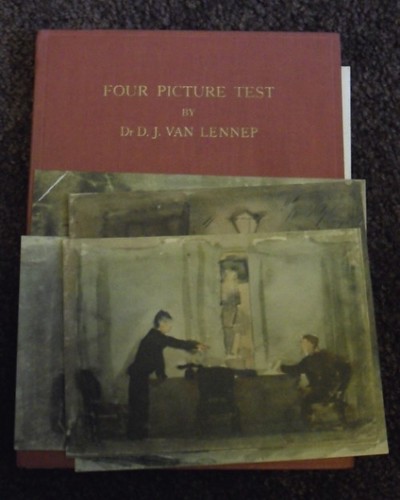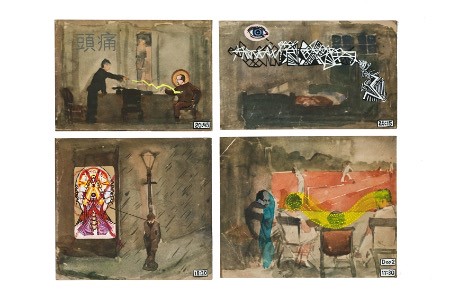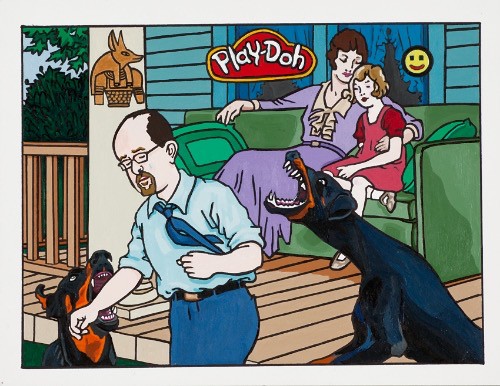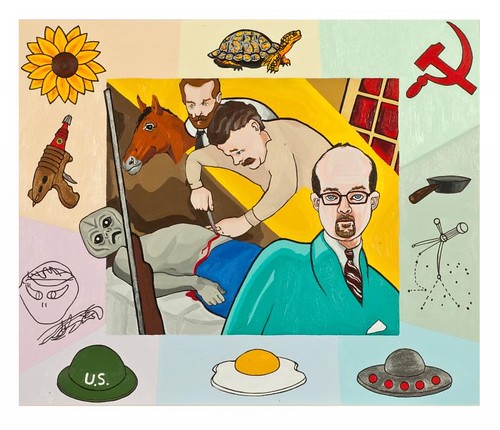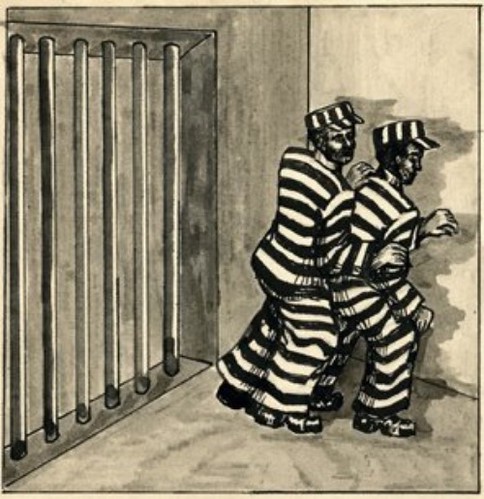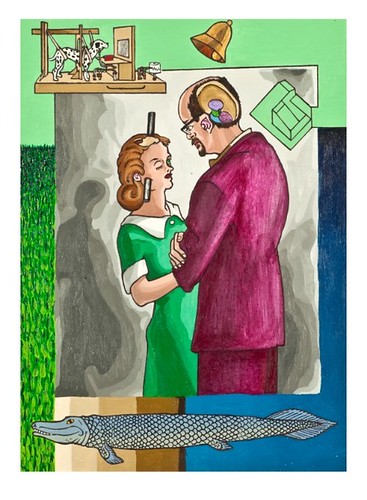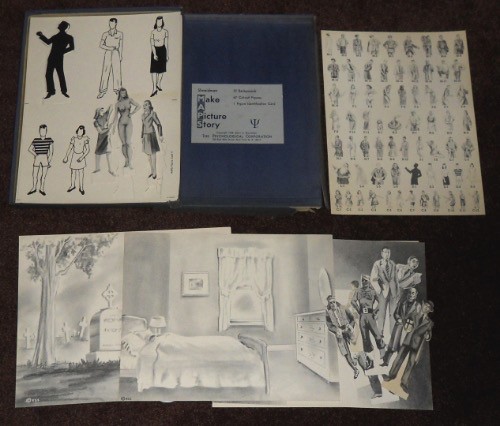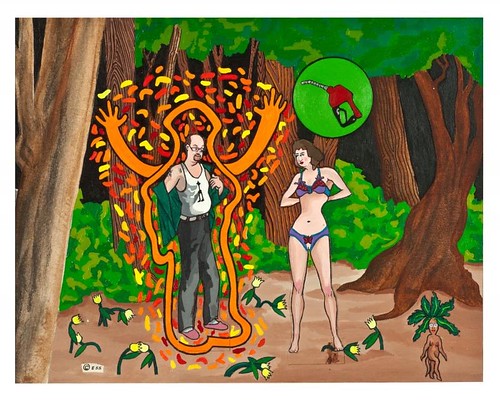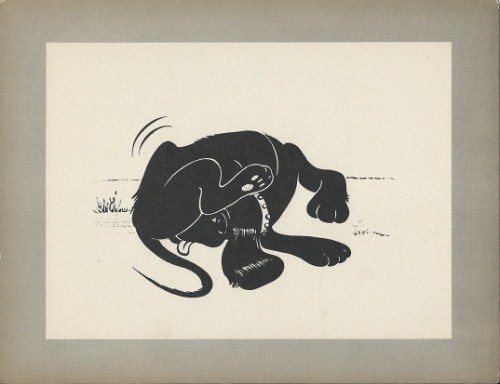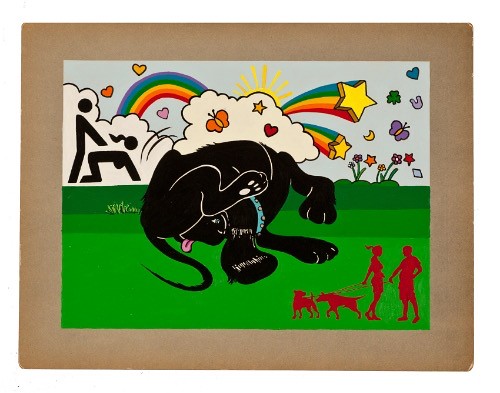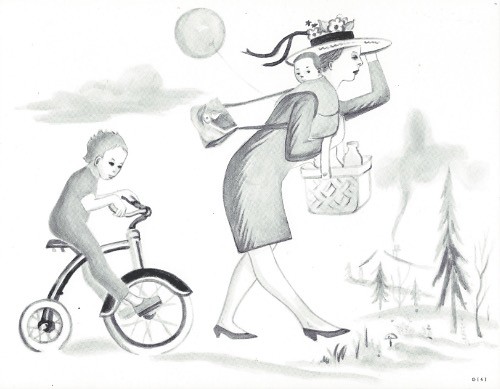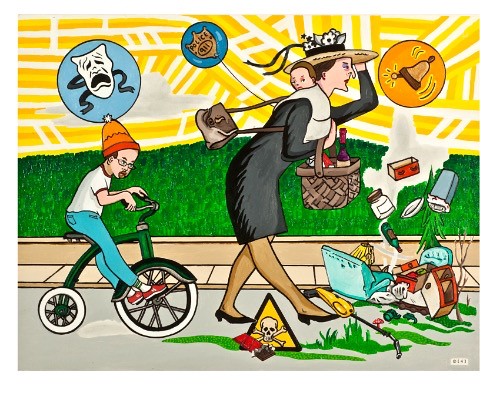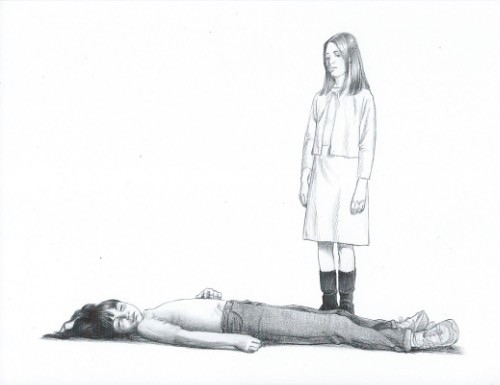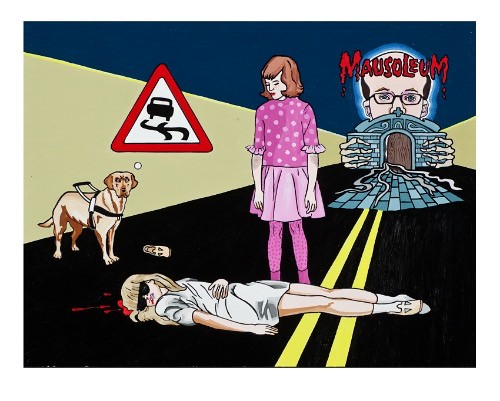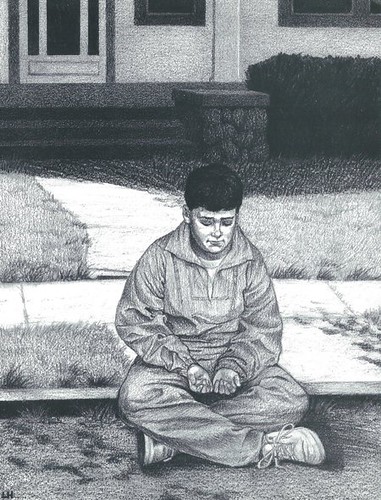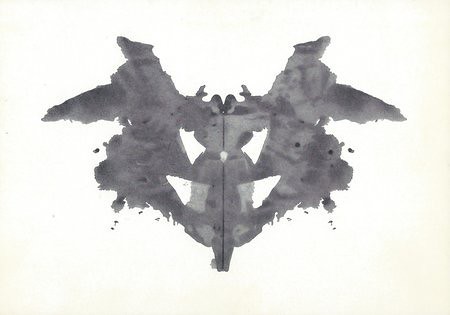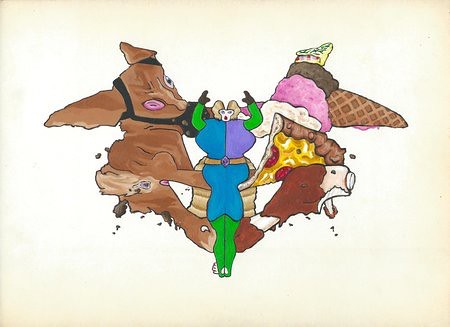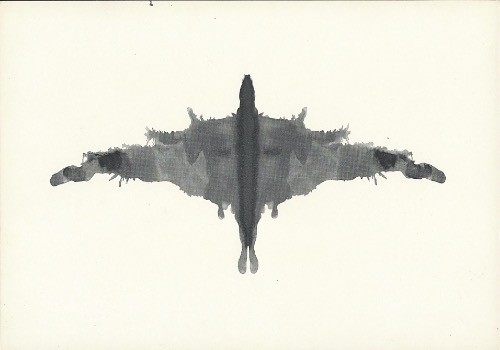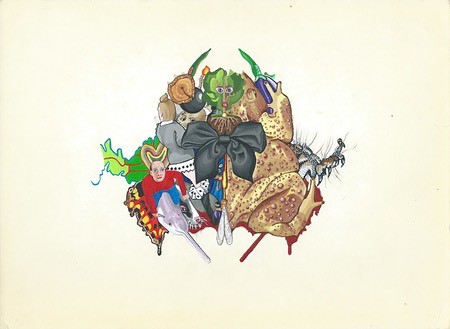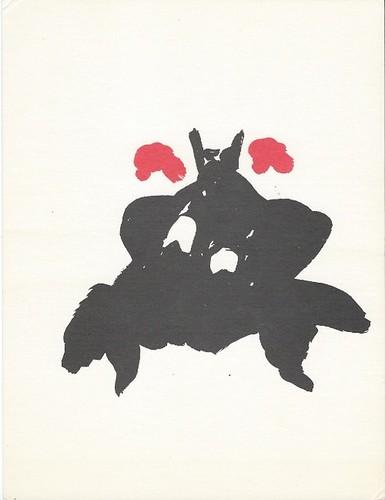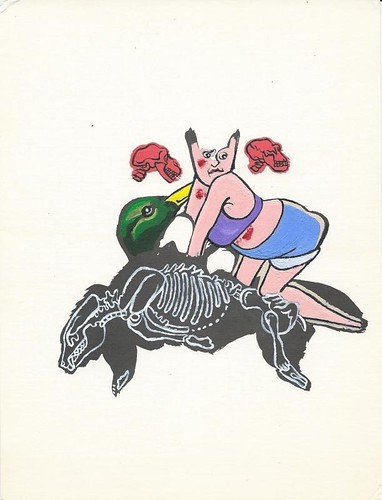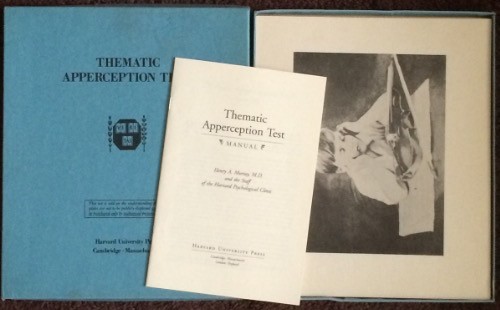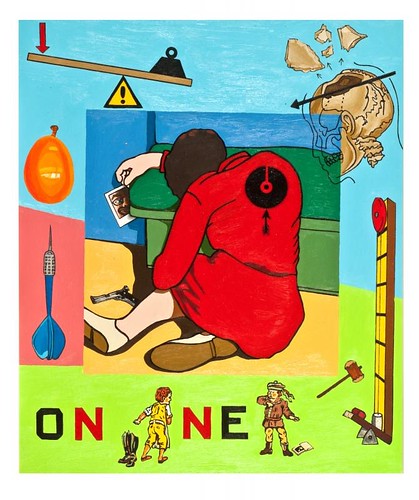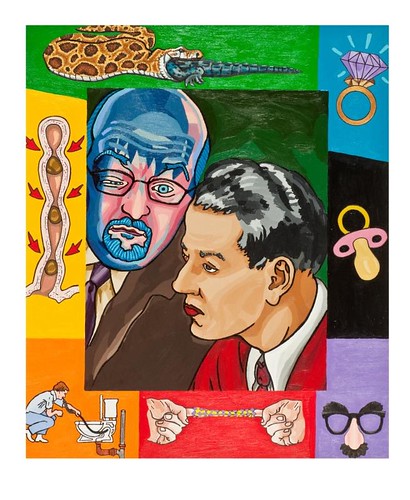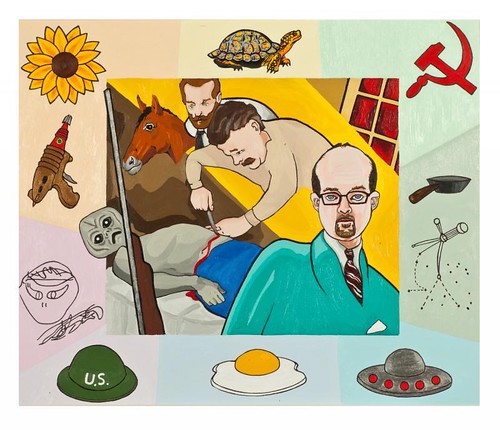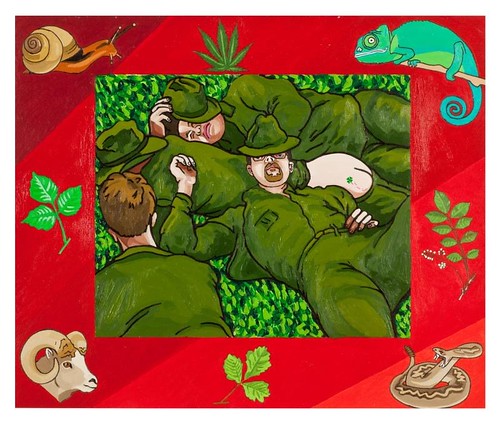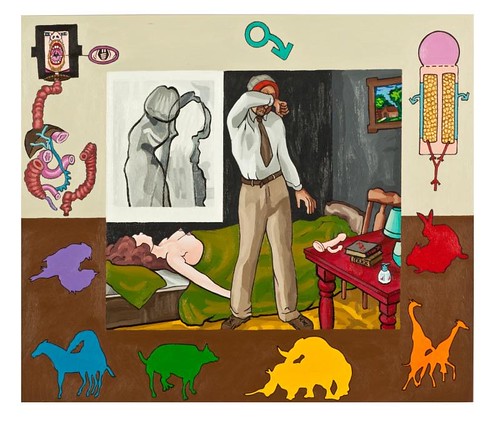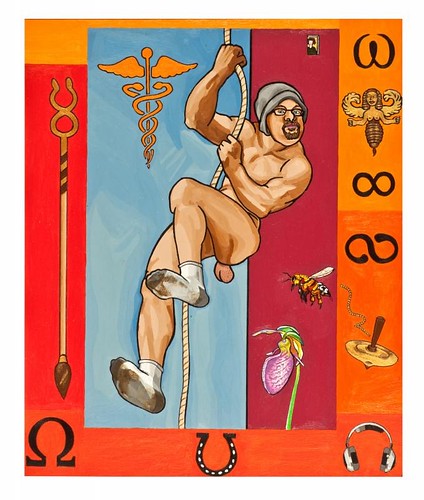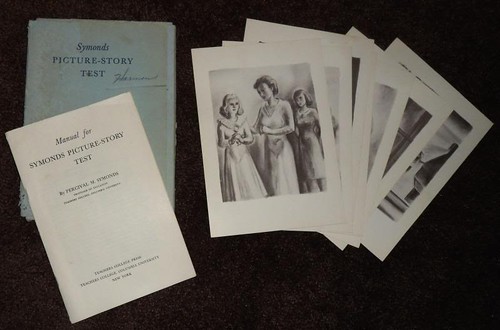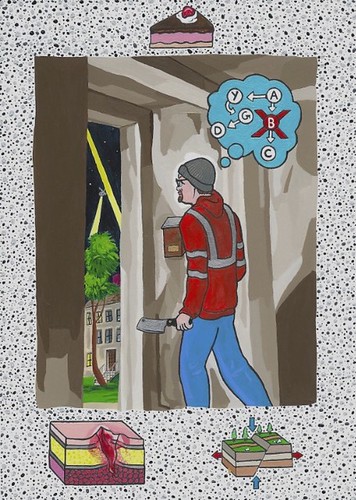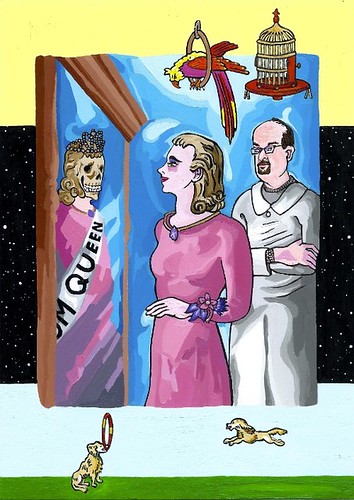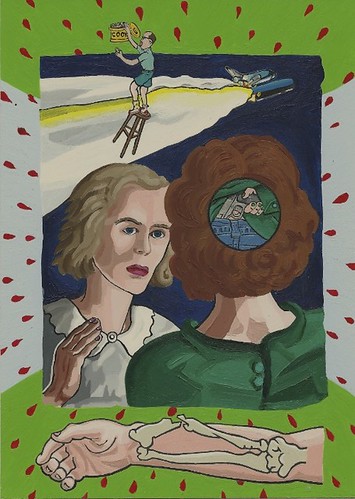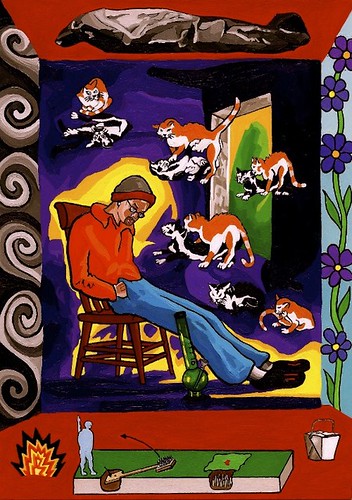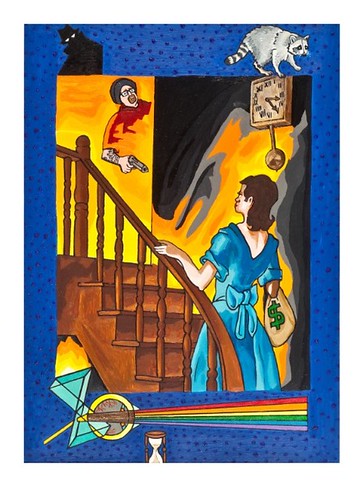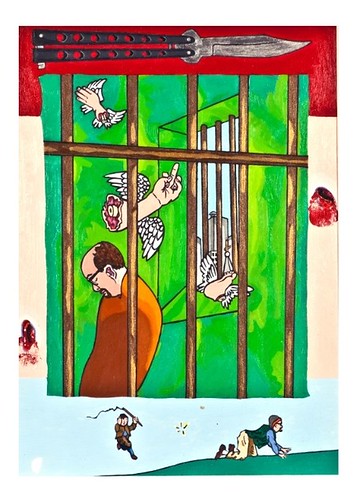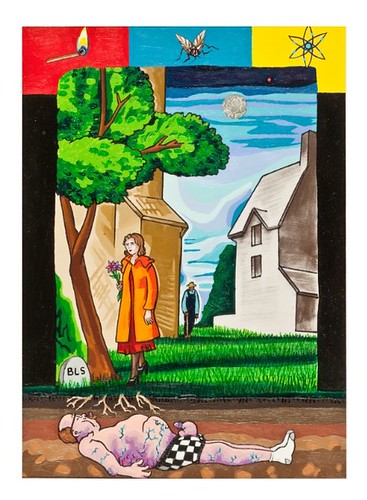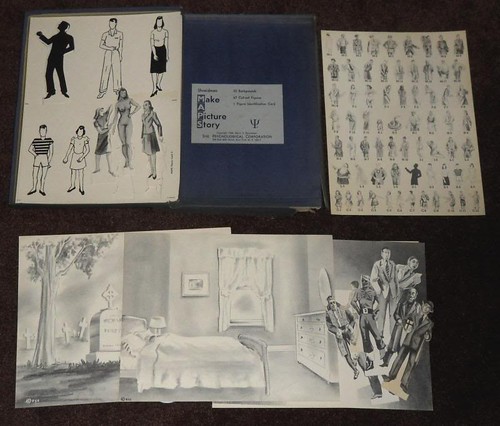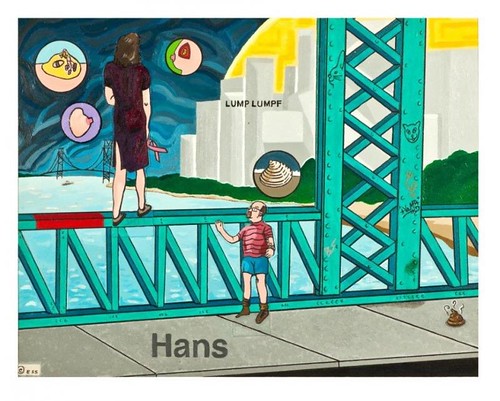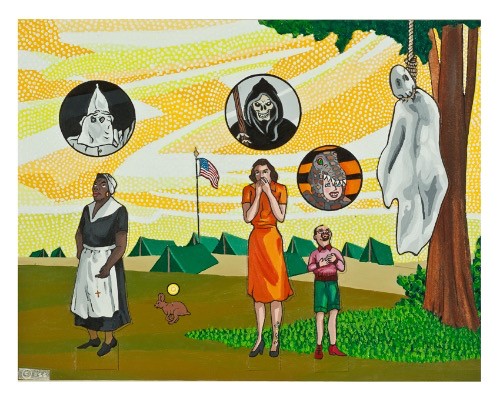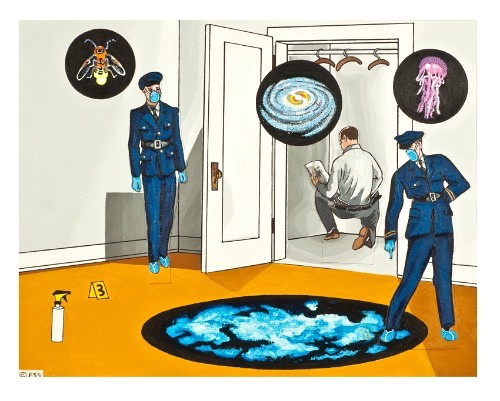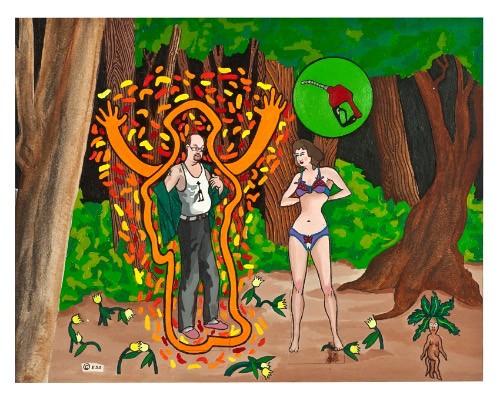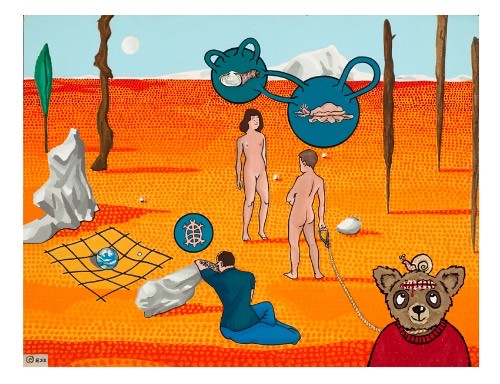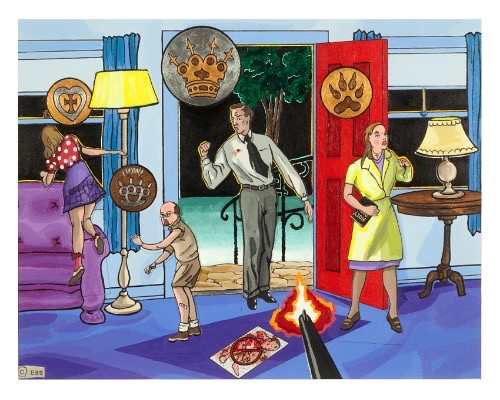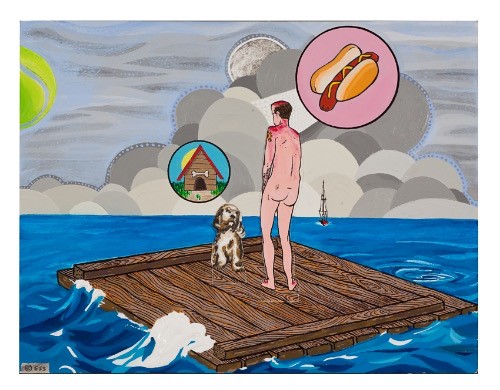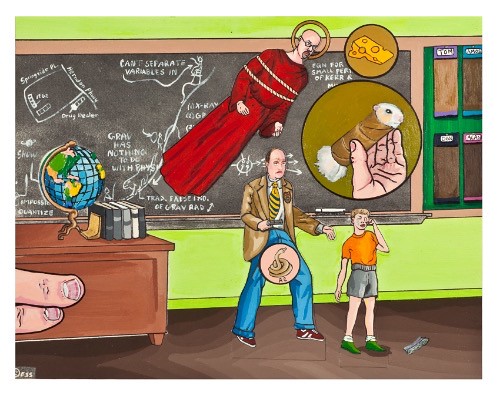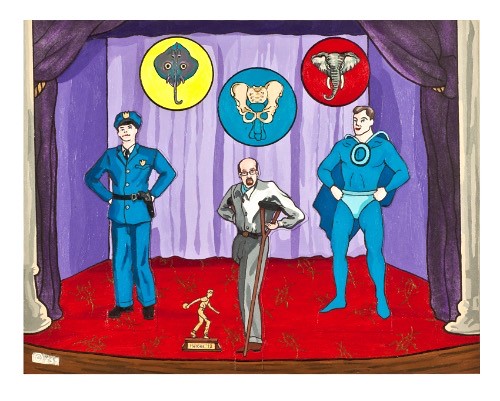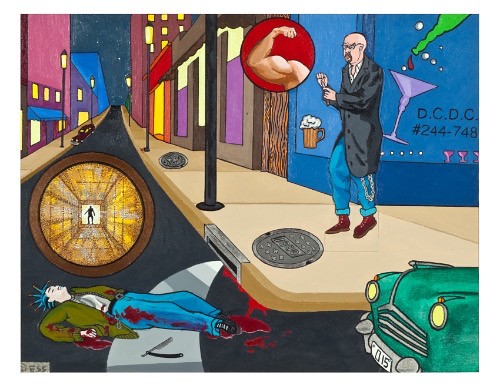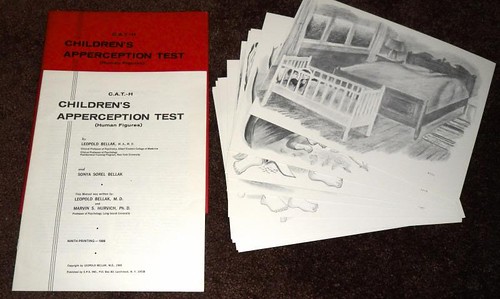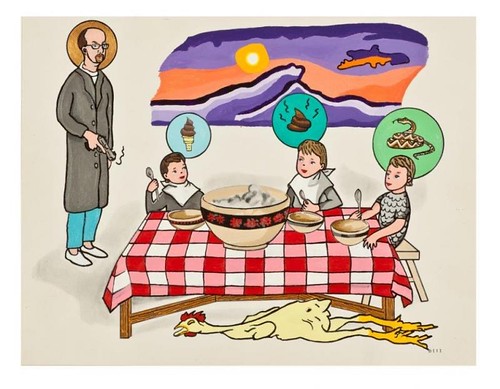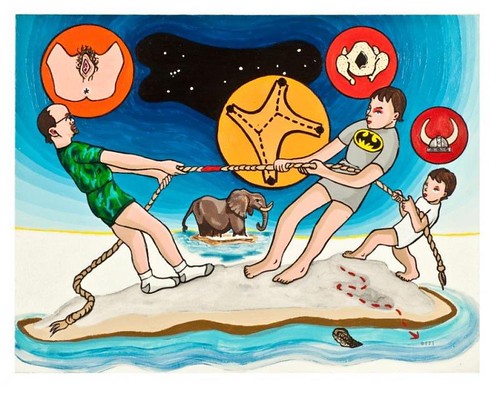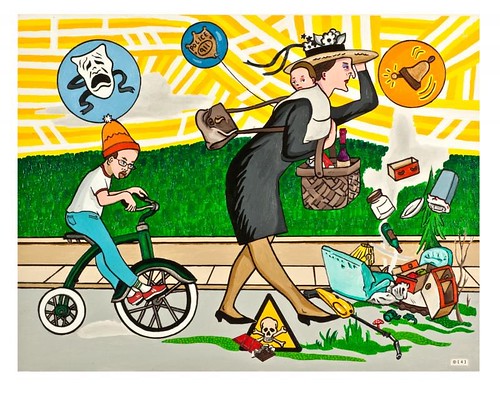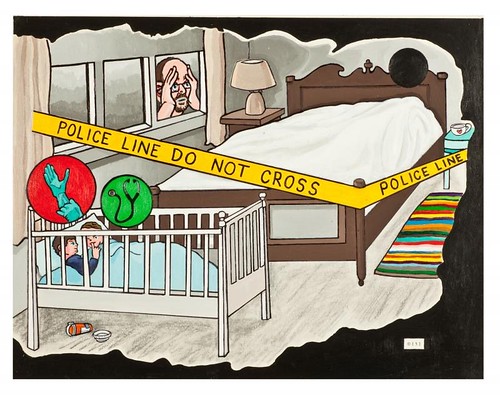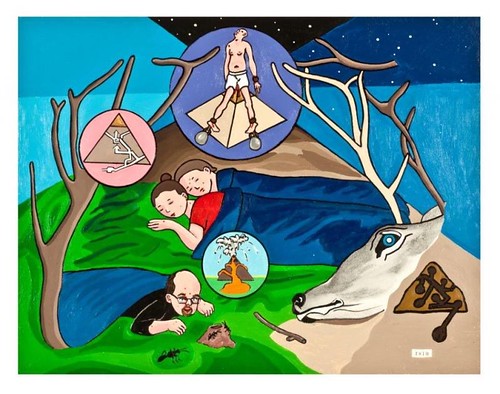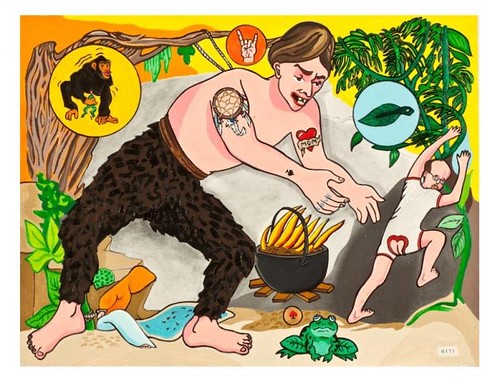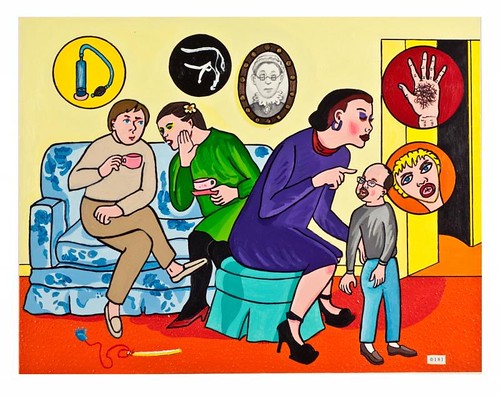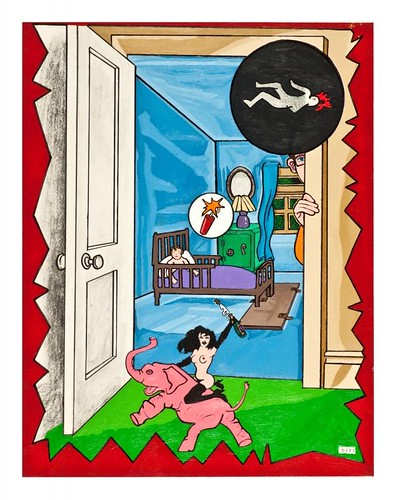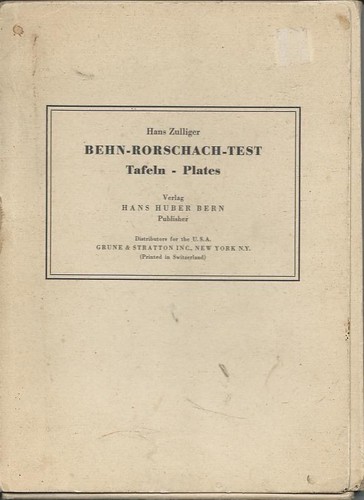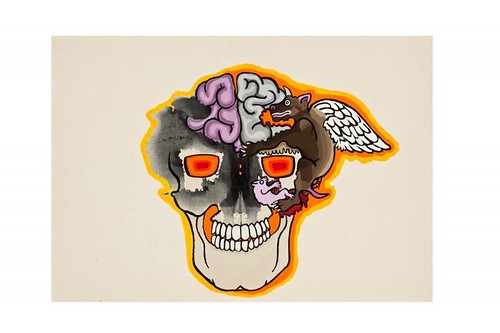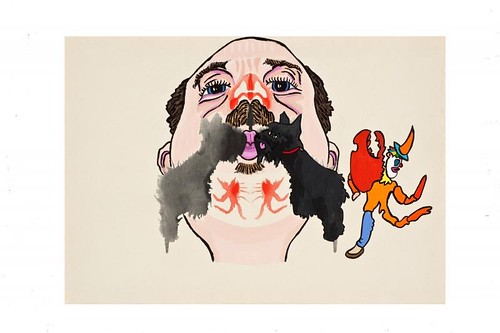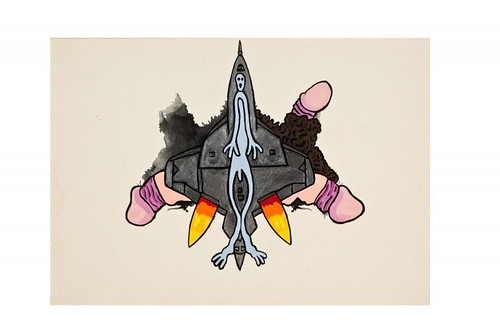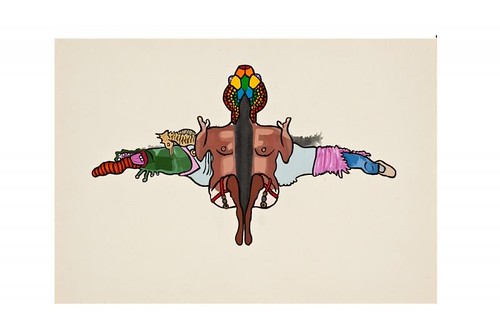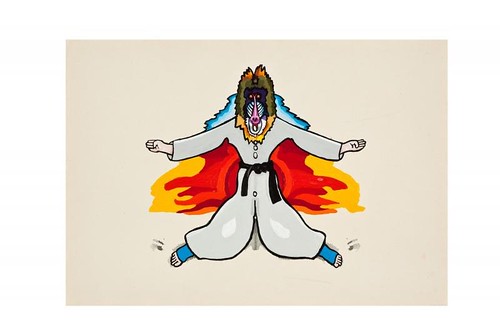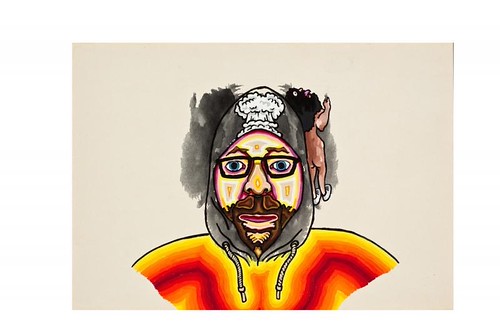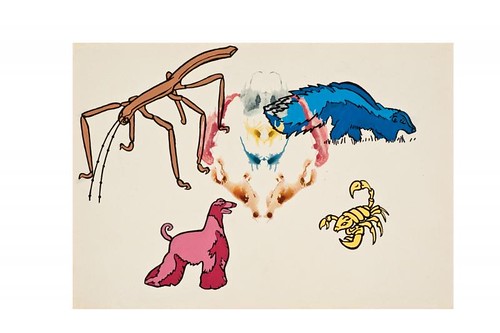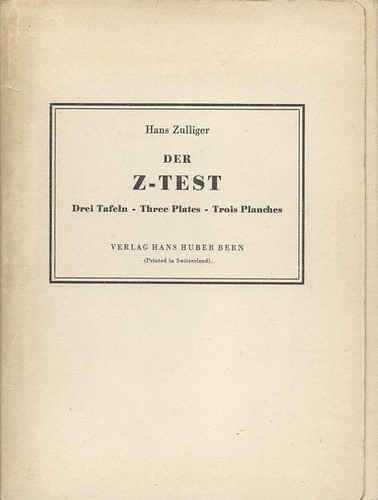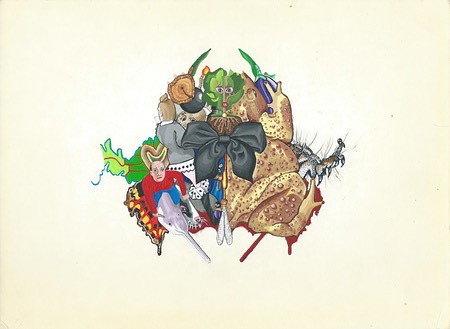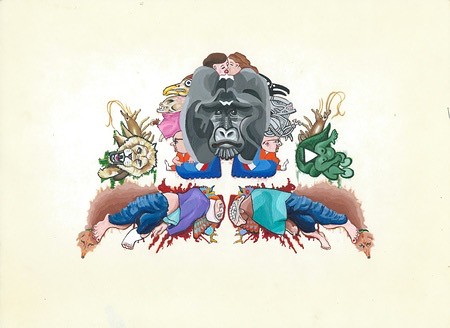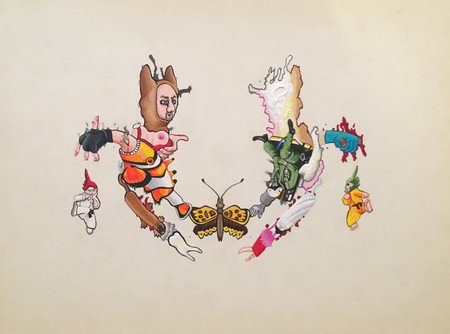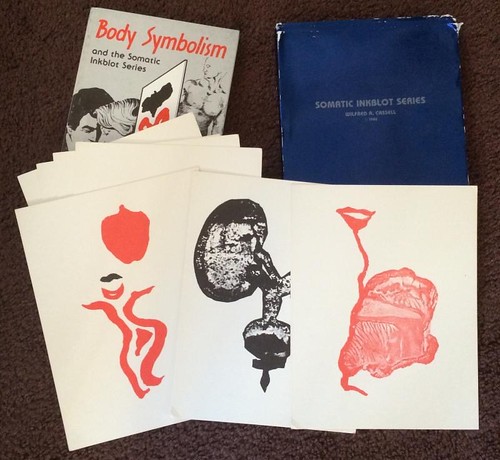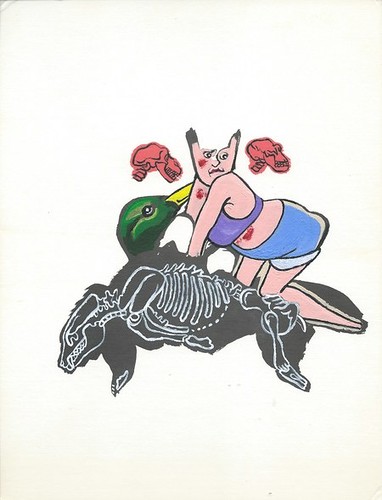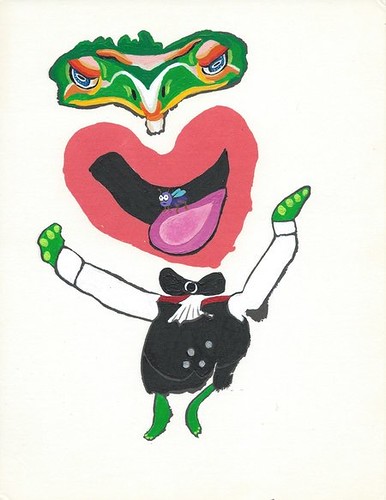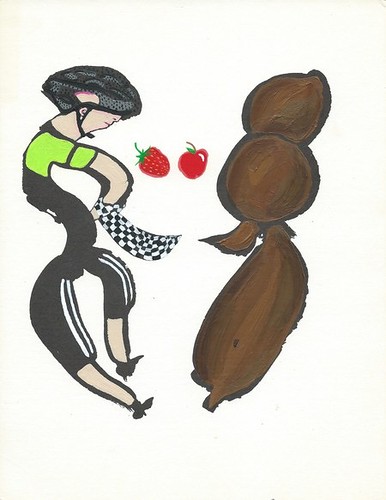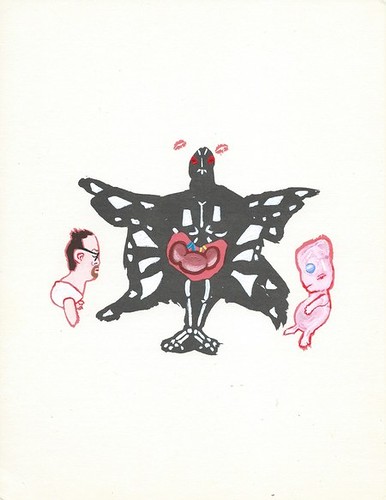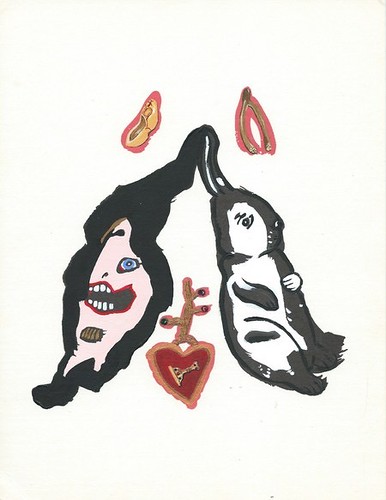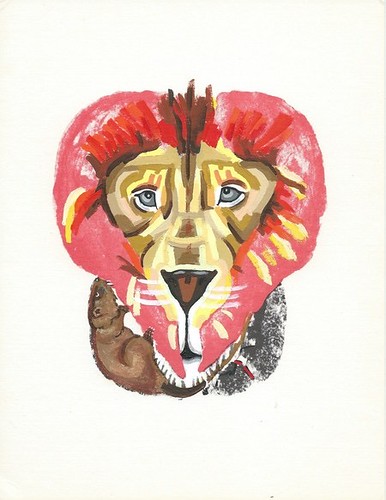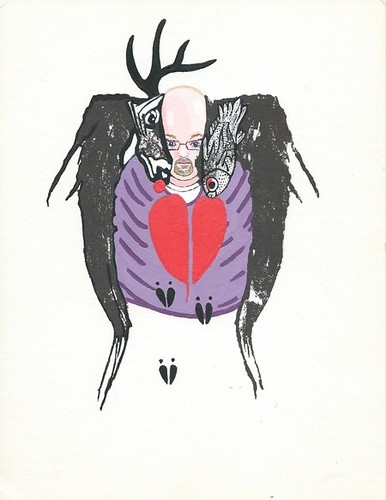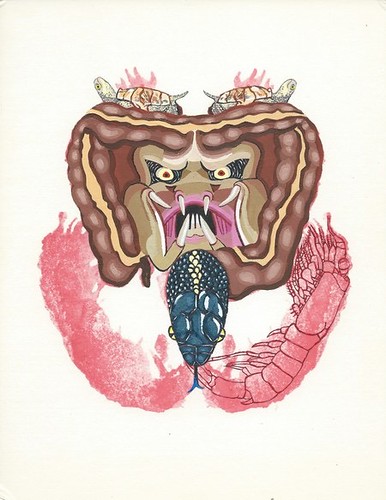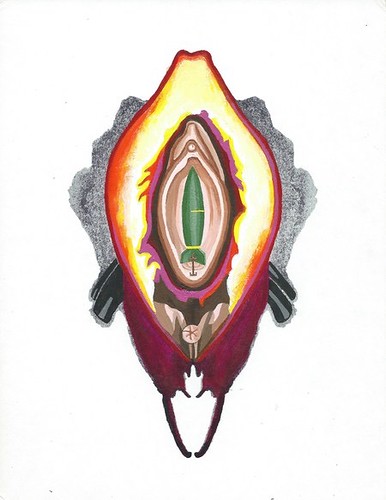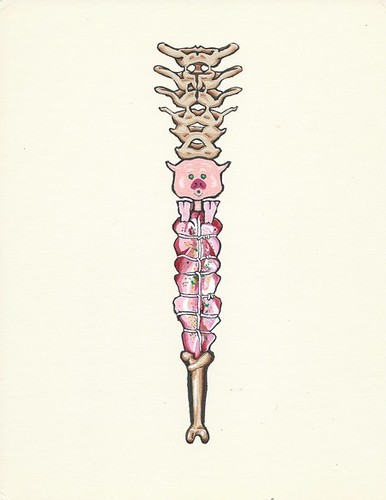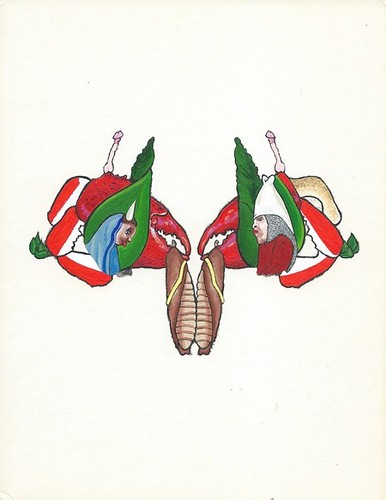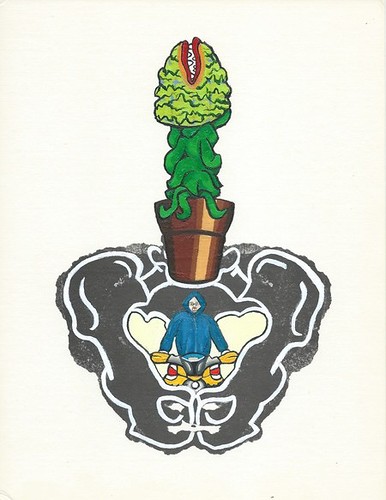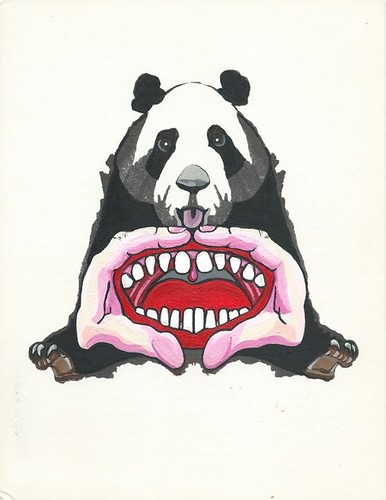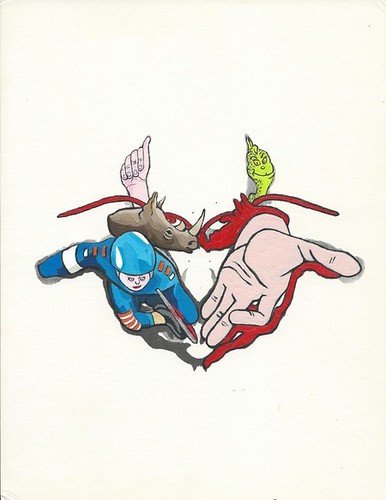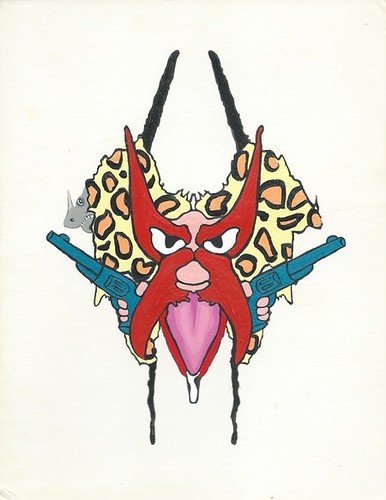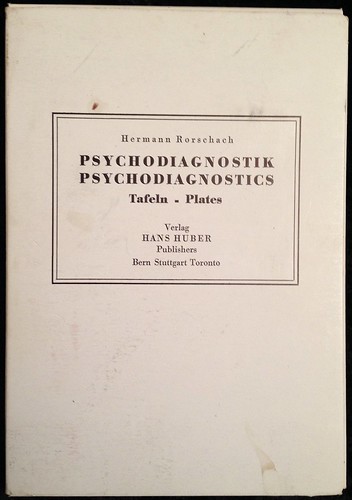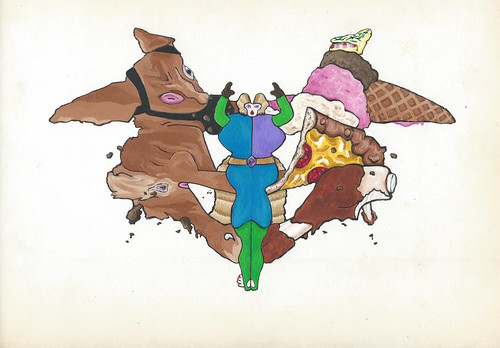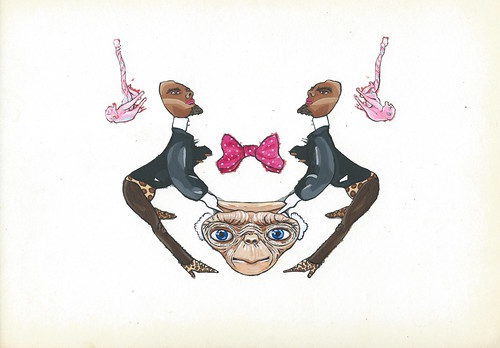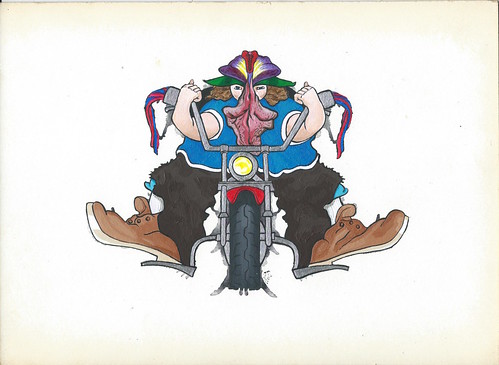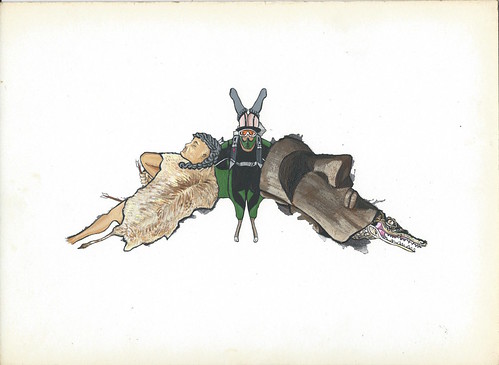"In defense of a psychological freedom, I apply therapy to the diagnostic tools cutting out the middle man. We don't need another doctor, we can run our own tests." - B.L. Saunders
ESSAYS / ARTICLES / PRESS:
Liberation (Les 400 Culs) Artcile Part 1 by Agnès Giard (French)
Liberation (Les 400 Culs) Article Part 2 by Agnès Giard (French)
Testing,Testing: Bryan Lewis Saunders
Oculus Vol. 1 Issue 2, "The Psychological", Edgar Wind Society, Oxford Univ. U.K.
Below are some images from one of the world's largest private collections of rare and vintage psychological tests. This collection, the majority of which was purchased from the estate of Saul Rosenzweig, has a large concentration of apperception and projective tests. Over the last few years I have often used these tests as the source material for my daily self-portrait ritual and therapy. While a couple of these tests were believed to have been lost forever to history, some of them are still in use today. Despite the large amount of skepticism and criticism surrounding the validity of these tests, as well as their age, many local court systems, government agencies, mental health care providers, schools, as well as employers from around the world still find a few of these tests invaluable.
THE COLLECTION:
Adolescent Apperception Cards (AAC) White Version, Leigh Silverton Ph.D., 1993
Adolescent Apperception Cards (AAC) Black Version, Leigh Silverton Ph.D., 1993
A. R. Root's Introversion-Extroversion Test, A. R. Root, 1932
Attitude-Interest Analysis Test, Lewis M. Terman and Catherine Cox Miles, 1936
Behn-Rorschach-Test, Hans Zulliger, 1941
Bender Motor Gestalt Test, Lauretta Bender M.D., 1938
Blacky Pictures, Gerals S. Blum, 1950
Children's Apperception Test (C.A.T.), Leopold and Sonya Sorel Bellak, 1949
Children's Apperception Test (C.A.T.-H) Human Figures, Leopold and Sonya Sorel Bellak, 1966
Children's Apperception Test (C.A.T.-S) Supplement, Leopold and Sonya Sorel Bellak, 1952
Childrens Apperceptive Story-Telling Test (CAST), Schneider, 1989
Children's Self-Report and Projective Inventory (CSRPI), Robert L. Ziffer and Lawrence E. Shapiro, 1992
Columbus, M.J. Langeveld, 1969
Composite Free Association, F. L. Wells, 1927
Court Preparation Set / Chris Tells the Truth Booklet, Kent R. Caruso, PhD., 1988
Design Judgment Test, Maitland Graves, 1948
Der Z-Test, Hans Zulliger, 1951
Developmental Test of Visual-Motor Integration Stimulus Cards, Keith E. Beery and Norman A. Buktenica, 1982
The Draw-A-Person Catalogue for Interpretive Analysis, Willia H. Urban, 1989
The Early Memories Procedure, Arnold R. Bruhn, Ph.D., 1989
Education Apperception Test (EAT), Thompson and Sones, 1975
Family Apperception Test (FAT), Wayne M. Sotile et al, (Julian, Henry and Sotile), 1985
Family Relations Indicator (FRI), J.G. Howells and J.R. Lickorish, 1962 / German Version Familien-Beziehungs-Test (FBT)
Four Picture Test (FPT), Dr. D.J. Van Lennep, 1930
Fuchs-Rorschach-Test (Fu-Ro-Test), Christel Drey-Fuchs, 1958
Full-Range Picture Vocabulary Test, R. B. Ammons, 1948
Goodenough Test of Drawing a Man, F.L. Goodenough, 1926
Goodenough-Harris Drawing Test, F.L. Goodenough, Dale B. Harris, 1963
Hand Test, Edwin E. Wagner, Ph.D., 1962
Healy Pictorial Completion Test II, William Healy, 1918
Holtzman Inkblot Technique, Wayne H. Holtzman, 1958
Homosexual Apperception Test (HAT), Saul Rosenzweig, 1940 (Reproduction)
House / Tree / Person Test (HTP), John Buck, 1948
Incomplete Man Test / Copy Form Test, Arnold Gesell, 1925
Illinois Test of Psycholinguistic Abilities, Samuel A. Kirk, James J. McCarthy and Winifred D. Kirk, 1961
Kent-Rosanoff Free Association Test, Grace H. Kent and Aaron J. Rosanoff, 1910
Le Test Patte-Noire (Le Test PN), Louis Corman, 1961
Make A Picture Story Test (MAPS), Edwin S. Shneidman, 1948
Meier Art Tests 1. Art Judgment Test, Norman Charles Meier, 1940
Michigan Picture Test (MPT), G. Andrew, S.W. Hartwell, M.L. Hutt and R.E. Walton, 1953
Minnesota Multiphasic Personality Inventory (MMPI) S.R. Hathaway and J.C. McKinley, 1964
Minnesota Paper Form Board Test Series A & Revised Minnesota Paper Form Board Test, Rensis Likert and Wm. H. Quasha, 1934
Neymannn-Kohlstedt Diagnostic Test for Introversion and Extroversion, Neymannn-Kohlstedt, 1928 Revision
Optionary for F - Reactions, (Unknown), (Unknown) [Frustration Test]
Otis Self-Administering Tests of Mental Ability, Arthur S. Otis, Ph.D. and Thomas N. Barrows,A.B., 1929 [Intermediate Forms A-D & Higher Forms A-C]
Pain Apperception Test (PAT), Donald Petrovich Ph.D. 1973
Pickford Projective Pictures, R.W. Pickford, 1963
Projective Story Telling Cards, Kent R. Caruso, PhD., 1987
Projective Story Telling Cards (Supplemental Series), Kent R. Caruso, PhD., 1988
Projective Story Telling Cards (Satanic Panic Supplemental Series), Kent R. Caruso, PhD., 1989
Projective Use of Mother and Child Drawings, Manual for Clinicians, Jacquelyn Gillespie, Ph.D., 1994
Purdue Perceptual-Motor Survey, Dr. Eugene G. Roach and Dr. Newell C. Kephart, 1966
Roberts Apperception Test for Children Test Pictures (RATC), Glen E. Roberts Ph.D., 1982
Roberts Apperception Test for Children Supplementary Test Pictures for Black Children, Glen E. Roberts Ph.D., 1986
Roberts-2 Test Pictures, Glen E. Roberts Ph.D., 2001
Psychodiagnostics Tafeln Plates, Hermann Rorschach, 1921
Revised Examination for the Measuremnet of Efficiency of Mental Functioning, Babcock-Levy, 1940
Rosenzweig Picture Frustration Test (P-F Study) (Adult Form German), Saul Rosenzweig, 1948
Rosenzweig Picture Frustration Test (P-F Study) (Adult Form English), Saul Rosenzweig, 1948
Rosenzweig Picture Frustration Test (P-F Study) (Adult Form English), Saul Rosenzweig, 1948 (Reproduction)
School Apperception Method, Irving L. Solomon, Ph.D. and Bernard D. Starr, Ph.D., 1968
Senior Apperception Technique (S.A.T.), Leopold Bellak and David M. Abrams Ph.D, 1998
Social Intelligence Test, F. A. Moss, T. Hunt, and K. T. Omwake, (1955?)
Social Situation Pictures (Male), Dr. Louis A. Schwarz, 1932
Social Situation Pictures (Female Supplement), Dr. Louis A. Schwarz, 1932
Somatic Inkblot Series (SIS), Wilfred A. Cassell, 1980
Stenquist Mechanical Aptitude Tests, J. L. Stenquist, 1921
Storytelling Card Game, Richard A. Gardner, M.D., 1988
Symonds Picture-Story Test (PST), Percival M. Symonds, 1948
Szondi Test, Léopold Szondi, 1935
Test of Visual-Perceptual Skills (Non-Motor) Revised Test Plates-Part I and Part II, Morrison F. Gardner, 1996
Thematic Apperception Test, Henry A. Murray M.D. and Christiana D. Morgan, 1935
Thematic Apperception Test (Thompson Modification) or Thompson-TAT, CE Thompson, 1949
The Personality Inventory, Robert G. Bernreuter, 1931
Thurston-Cradock Test of Shame (TCTS), Nancy S. Thurston and Julie Cradock O'Leary, 2009
Thurstone Personality Shedule (Clark Revision), Raymond R. Willoughby, 1932
Vocational Interest Schedule, L. L. Thurstone, 1935 Edition
Vocational Interest Blank For Men, Edward K. Strong, Jr., (Revised) 1938 & Vocational Interest Blank For Women, Edward K. Strong, Jr., 1933
Wells Memory Test, Wells, 1943
Please contact me if you have any of the following tests for sale or trade:
Adoption Story Cards, Richard A. Gardner; ill. by Alfred Lowenheim,1978
IES Test, Dombrose and Slobin, 1958
Indian Modification of the Thematic Apperception Test, Uma Chowdhury, 1967 & Pacific TAT.
The Insight Test, Helen D. Sargent, 1953
Michigan Picture Test Revised (MPT-R), M.L. Hutt, 1980
Object Relations Technique (ORT), Herbert Phillipson, 1955
Picture Impressions Test, Lester M. Libo, 1957
Picture Perception Test and Discussion Test (PPDT),
Psychodiagnostic Inkblots. A Parallel Series to Rorschach, M.R. Harrower Ph.D., 1945
Rosenzweig Picture Frustration Test (P-F Study), Saul Rosenzweig [child form 1948, adolescent form 1970 only]
School Apperception Story Procedure (SASP), Raya A. Jones, 2001
Separation Anxiety Test (SAT), H.G. Hansburg, 1972
South African Picture Analysis Test (SAPAT), Barend Frederik Nell; Andries Jacob Kruger Pelser, 1960
Symbol Elaboration Test (S.E.T.), Johanna Krout, 1950
Tasks of Emotional Development Test (TED Test), Haskel Cohen and Geraldine R. Weil, 1971, 1975
Tell-Me-A-Story (TEMAS) Stimulus Cards and Minority Stimulus Version, Costantino, Malgady and Rogler, 1988
Test of Family Attitudes (TFA), Lydia Jackson, 1952
Themes Concerning Blacks (TCB), R. L. Williams, 1972
Visual Apperception Test (VAT), Rafi Z. Khan, 1960
ABOUT THE TESTS
All of the "picture story" tests are based on the belief that vague and ambiguous imagery can elicit stories that will reveal subconscious traits of our personalities. After all, within our personal stories lie our deepest motivations, fears, desires, fantasies, conflicts, needs, beliefs, thoughts, memories, feelings, nightmares, attitudes about relationships and the list goes on. The problem is, and has always been, that evaluating a story has frequently been declared an art form itself. When evaluating the results of these tests there has never been a standard analytic technique or norm. And because everyone was able to create their own scoring system, these tests would often end up saying more about the test administrator than they would about the test subject. It was my belief from the start that by taking on the roles of both doctor and patient, at the very least I should learn something about myself through this bias alone.
Below are some 'before and after' examples of how I took the tests. Instead of responding verbally to the test cards, which is always the directive, I read the instructions and then answered the tests visually. I did this by drawing and then painting my responses directly on top of the test cards themselves. By adding my own objects, thought bubbles, symbols and details, I brought clarity to the unclear situations and people depicted. In return, the stories began to develop subconsciously. I then realized that it might be possible to illustrate my own personality. I disregarded my superego to the best of my abilities and tried extremely hard not to censor anything even from myself. After I finished each test card, I wrote down a brief description of the story that had developed, or answered the questions provided in the accompanying manual, so I could later evaluate the images using simple statistics on specific themas and personal symbols that I deemed most important to me at the time. The results have been personally insightful.
FOUR PICTURE TEST (FPT)
by Dr. D.J. van Lennep (1930)
3 - 2 - 1 - 4 (The order of cards in which I created my story)
I was standing outside in the rain when my neck started getting stiff and really hurting. So I went upstairs to lay down and then I got an ocular migraine. I went next door to see if my Chinese neighbor had any Excedrin and he shouted, "Tou Tong!”, meaning headache, and then he hit me in the chest with a martial arts lightning bolt and magically transformed my pain into a halo. The next day I felt hungover, drained and kind of blue so I went to a tennis match and told everyone at the country club about what had happened to me the previous evening.
SOCIAL-SITUATION PICTURES
by Dr. Louis A. Schwartz (1932)
Picture No. 7- “Let the dogs out!”
In the 5th grade a girl named Angie told me that if I came over to her house she would give me a recipe to make my own Play-Doh. When my friend Paul and I got to her house she let us inside and yelled, "Lindsay! Let the dogs out!" We got mauled by 2 Doberman Pinschers. We didn't know why she did this to us but we always thought her mother had put her up to it. At least we knew that her mother had taught her how to make Play-Doh.
THEMATIC APPERCEPTION TEST (TAT)
by Henry A. Murray & Christiana D. Morgan (1935)
8 BM- "Stalin and Van Gogn Perform an Alien Autopsy"
I am chief surgeon of a well respected European hospital. I feel very important. I am overseeing an alien autopsy being performed by Stalin and Vincent van Gogh. I have turned my back on them because I know I have taught them well. Like most chief surgeons my narcissism is so profound that it overshadows any curiosity to see what is actually inside of this the alien’s body. Stalin carefully makes the first cut. He mumbles to Vincent that the alien’s skin is as tough as a turtle shell. The alien is still alive and beginning to suffer physically. Both sad and mad the alien thinks, “I need my ray gun!”. I am looking at you as my mind begins to wander. I think about war, breakfast and flying saucers. I fantasize that while under hypnosis both Stalin and van Gogh had claimed to be abductees and that the autopsy is their way of exacting revenge. Not even sunflowers and the hammer and sickle can save the alien from their vengeful intentions. The horse is named Theo of course and he is the only one present capable of empathy. Vincent is a bit concerned that this will be their only chance to see what makes the alien tick and he is afraid that they might screw the procedure up. Even though I am chief surgeon, I am not in any position to save the alien. My hands have been tied by the bureaucrats above me. There is nothing we can do. Science creates the best art forms of killing. We are all doomed.
HOMOSEXUAL APPERCEPTION TEST (HAT)
Saul Rosenzweig (circa late 30s)
9- "I am my own worst Bubba!"
Prison has become a symbol of rebirth for me. It is always the good spiritual side of me that lets me know when I’ve screwed myself over again. The good side is always full of negative self-talk. One would think it would be the other way around, but the bad side of me does stuff like dropping the soap on purpose and then waits for the good side to get behind me. The Ouroboros encircles the sewer like a hula hoop waiting for the pelvises of both sides to start gyrating. I messed up again. This time the government won’t ever be letting me go.
HOUSE/TREE/PERSON TEST (HTP)
by John Buck 1948
ANSWERS:
House: I live within the golden ratio. This is my dream home. I am very happy here. My life is structured perfectly as are the rooms around me. I make art and feed the animals outside. At night it’s like a zoo except the animals are all free to come and go as they please. I have visitors on special occasions, but mostly it acts as my hideout. It is a place where I always feel safe. The rooms are colorfully painted and reflect the spectrum. Starting with a red living room and spiraling inwards and downwards all the way to an indigo bathroom and the laundry/utility room is a nice violet.
Tree: This a young redwood. It has been cut down long before reaching the prime of its life. It is 45 years old, the same age as me. It is very hard to count the rings. It had lived through floods and droughts but it could not survive the progress of mankind. Now it’s just a stump, and yet it gets a lot of sunshine.
Person: The person is me. I am 45. My favorite thing to do is drawing. That and feed wild water turtles. I don’t like big crowds. Nicole Bailey looks out for me. I am thinking about how accurately I want to portray my likeness. I am fairly tired.
SYMONDS PICTURE-STORY TEST
by Percival M. Symonds 1948
8 B- "The Problem with Arguing"
I got into an argument with a woman. I was telling her about tiktaalik and she got upset and responded badly. Though I didn't know all of the facts, I was doing the best I could to explain evolution to her. I felt like I only had part of the story. Once emotions got involved, I felt like I had a reptilian brain and that she had turned into Phineas Gage after the accident, an emotional basket case. As the conversation turned to behaviorism with the logic part of my brain missing, it could only seem like the puzzle was being put together with incorrect geometry. There was no winning this argument. It was a stalemate. We weren’t on the same page. It was then that I realized people’s thought processes can work very very differently.
MAKE A PICTURE STORY (MAPS)
by Edwin S. Shneidman 1948
13. Forest - "We Ran Out of Gas"
Nicole and I were driving through the woods looking for what we call our “wild neighbors”. Our animal friends living near our home. As always, she was looking really beautiful that evening so I pretended like we ran out of gas. I did this so I could try to put the moves on her and have crazy animal wild neighbor sex in the woods. Once out of the car I became Desena, a Native American sacred fire spirit ready for love! Nicole was thinking, "We ran out of gas? Yeah right! I am going to pour some gas on that ass!” The flowers imitated all of the different sex positions they witnessed. Little did we know that there was a boy hiding behind a tree watching all of this. When we found out later, that was a little creepy.
THE BLACKY PICTURES
by Gerald S. Blum 1950
Cartoon V- "Masturbation Guilt / Lucky Charms"
Answers:
1. (a) Blacky is happy without a care in the world.
2. (a) When he is older and doing this he will still be happy without a care in the world.
3. Blacky is thinking about a girl dog he met at the park.
4. Blacky has no irrational fears concerning this behavior.
5. If Mama comes over and finds Blacky she won’t say anything. She will go away and give him his privacy.
6. If Papa comes over and finds Blacky he will make a joke to lighten the awkwardness of the situation and maybe say, “Sorry to bother you son.” then Papa will go away and give Blacky his privacy.
CHILDREN'S APPERCEPTION TEST (HUMAN FIGURES)
(C.A.T.-H)
by Leopold and Sonya Sorel Bellak 1966
C.A.T.-H 4- "The Crazy Lady Across The Hall"
When I was six years old, I lived in an apartment in Long Beach, California where a severely emotionally-disturbed woman lived across the hall. She looked like a witch, and whenever I made a loud noise, like accidentally letting wind blow the front door shut, the woman would suddenly fly into a rage and begin smashing everything in sight. All the residents in the building would immediately stop what they were doing and listen to her break dishes, bottles, and mirrors, violently empty her closets, cabinets, and drawers, and then drag her furniture back and forth across the floor until she either exhausted herself or was taken away by the police. Meanwhile at school, a lot of the Mexican children were unusually cruel to me. They threw sand in my face and then chased me away; and if they caught me, they would beat me until I soiled myself. On one such occasion, I had managed to run away from them but got lost in the process until I found myself wandering around the streets of Long Beach, alone, scared, and disoriented. While looking for a police officer to help me get home, I saw the disturbed lady from my apartment building riding her bicycle. Secretly, I followed her and safely made it home. A month or so later on Halloween, much to my surprise, the disturbed lady gave me a giant chocolate bar, the first nice gesture she had ever shown me. My parents and their friends, on the other hand, were more cautious. Immediately, one of them snatched it from me, passed it around, took turns inspecting it, and smelled it before finally throwing it in the trash for fear that she had poisoned it.
ROBERTS APPERCEPTION TEST
by Glen E. Roberts Ph.D., 1982
Card 4- "Night at the Movies"
When I was 14 my mother wrote a note for me so I could get into R rated movies without being accompanied by an adult. One night I went to see Mausoleum alone and noticed a blind girl in line at the theater behind me. Before the movie started I was looking around the theater and the blind girl and her dog were sitting in the very back row. It struck me as odd that a blind girl would see a scary movie alone but who was I to judge. Anyway, after the movie ended I went to the bathroom. When I came outside of the theater there were cop cars and an ambulance on Elden St. in front of the theater. I ran over to see what had happened and the blind girl had got run over and was laying in the road. The dog also got run over and was breathing heavy but I didn't want to paint that I thought it would just be too much to handle. I sometimes wondered if she had stepped out in front of the traffic on purpose, as if she went to see a movie blind and then committed suicide. Or maybe the soundtrack just knocked her senses out of whack. I don't know, could have just been an accident I guess.
ADOLESCENT APPERCEPTION CARDS (WHITE VERSION)
(AAC)
by Leigh Silverton, Ph.D., 1993
2M- "The Quest of the Absolute"
Immediately after graduating from college I started reading feverishly. I must have read over 100 books in only six months. At one point I had just finished reading a book by Freud and had started to read a book by Balzac when all of the sudden different connections from different books started rapidly forming in my mind and my head instantly became engulfed in flame. It was a hallucination brought about by the written language. Even though the flames were not hot, I was still screaming and running for my life because it was terrifying. I ran out of the building and down the street trying to smack the flames out and get the flames out of my eyes. I even tried to outrun them. I returned home and just sat there with the top of my head on fire. It was an incredible experience. I often find myself unconsciously trying to have this experience with materials from the visual arts, but no so far no luck. The only other time I have experienced this was during the “Third Ear Experiment”. Given enough quiet and peacefulness in my environment I could recreate the head engulfed in flames hallucinations whenever I wanted to. It got to where it was pretty fun.
PSYCHODIAGNOSTIK
by Hermann Rorschach 1921
Plate I
BEHN-RORSCACH-TEST
by Hans Zulliger 1941
Plate V
The Behn-Rorschach-Test was the first inkbblot test designed to deal with criticisms that had arisen concerning the accuracy and validity of the Psychodiagnostiks by Hermann Rorschach. I took this test over the course of 5 sessions while microdosing myself with psilocybin mushrooms. During session 1, I outlined everything I saw on all 10 test cards as best as I could. During sessions 2 through 5 I painted them all in. I had hoped that since both the inkblot tests and psychedelics could be used as tools to explore the inner self that interesting things would emerge from the combination of the two. However, when the doaseage was too strong I was unable to accurately illustrate my perceptions as they were constantly changing. My motor skills were also heavily effected and I was unable to render much in the way of any details. It was only when the effects had begun wearing off that could I clean up and erase and focus on basic lines and shapes with more precision.
DER Z-TEST
by Hans Zulliger 1951
Plate I
Ten years after publishing the Behn-Rorschach-Test, Hans Zulliger created Der Z-Test. I took this test completely sober and the difference is remarkable. I was able to focus with extreme clarity on minute details of the inkblot whcih lent itself extremely well to my imagination. I could clearly see so many things everywhere all over the place. It was a really interesting and exciting experience.
SOMATIC INKBLOT SERIES
by Wilfred A. Cassell 1980
Plate 1
CLICK HERE TO VIEW FULL MIKA EXHIBITION CATALOG: ARTICLE, TEXT, INSTRUCTIONS AND IMAGES PDF
The first public exhibition of the psych tests took place in Tel Aviv, Israel July, 2014 from which a smaller selection was later exhibited again at SCOPE Art Fair, Miami, Florida in December, 2014. Some examples will be on view at Dolhuys Museum van de Geest in Haarlem, Netherlands beginning October, 2015 and will be on display for app. 14 months. See catalog above for written text and descriptions concerning the tests.
THEMATIC APPERCEPTION TEST (TAT)
by Henry A. Murray & Christiana D. Morgan 1935
Card 3 BM
Card 6 BM
Card 7 BM
Card 8 BM
Card 9 BM
Card 12 M
Card 13 MF
Card 17 BM
Card 18 BM
SYMONDS PICTURE-STORY TEST
by Percival M. Symonds (1948)
Card B1
Card B2
Card B3
Card B4
Card B5
Card B6
Card B7
Card B8
Card B9
Card B10
MAKE A PICTURE STORY (MAPS)
Edwin S. Shneidman (1948)
5. Bridge
6. Camp
7. Cave
10. Closet
13. Forest
14. Landscape
15. Living Room
17. Nursery
18. Raft
19. Schoolroom
21. Stage
22. Street
CHILDREN'S APPERCEPTION TEST HUMAN FIGURES
(CAT-H)
by Leopold and Sonya Sorel Bellak (1966)
Test Card 1
Test Card 2
Test Card 3
Test Card 4
Test Card 5
Test Card 6
Test Card 7
Test Card 8
Test Card 9
Test Card 10
BEHN-RORSCHACH-TEST
by Hans Zulliger (1941)
Plate I
Plate II
Plate III
Plate IV
Plate V
Plate VI
Plate VII
Plate VIII
Plate IX
Plate X
ZULLIGER: DER Z-TEST
by Hans Zulliger (1951)
Plate I
Plate II
Plate III
SOMATIC INKBLOT SERIES (SIS)
by Wilfred A. Cassell 1980
Plate 1
Plate 2
Plate 3
Plate 4
Plate 5
Plate 6
Plate 7
Plate 8
Plate 9
Plate 10
Plate 11
Plate 12
Plate 13
Plate 14
Plate 15
Plate 16
Plate 17
Plate 18
Plate 19
Plate 20
RORSCHACH PSYCHODIAGNOSTIK
Hermann Rorschach (1921)
Plate 1
Plate 2
Plate 3
Plate 4
Plate 5
MORE POSTS AND UPDATES TO FOLLOW
©Bryan Lewis Saunders 2013
All works made possible by donations from MIKA Contempoary, Brant WIthers, Hopek Quirin and Alice Salyer

